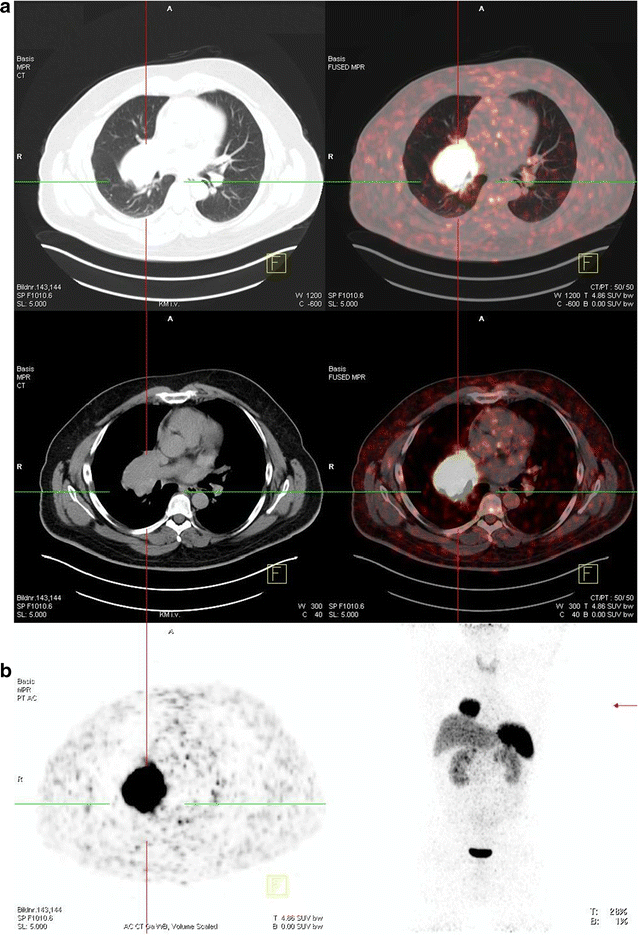Acromegaly in a patient with a pulmonary neuroendocrine tumor: case report and review of current literature
- PMID: 27349224
- PMCID: PMC4924317
- DOI: 10.1186/s13104-016-2132-1
Acromegaly in a patient with a pulmonary neuroendocrine tumor: case report and review of current literature
Abstract
Background: Pulmonary neuroendocrine tumors (NET) form a heterogeneous group of rare diseases. In these tumors, paraneoplastic syndromes have been described to drive the course of the disease, among them acromegaly induced by paraneoplastic secretion of growth hormone-releasing hormone (GHRH).
Case presentation: We report the case of a 43 years old patient initially diagnosed with acromegaly accompanied by weight gain and acral enlargement. Subsequently, further diagnostic work-up identified a solitary pulmonary neuroendocrine tumor (NET). Laboratory tests revealed markedly increased growth hormone (GH) and insulin-like growth factor 1 (IGF-1) without GHRH elevation in the absence of pituitary pathologies confirming the paraneoplastic origin of clinical presentation with acromegaly. Curative surgery was performed leading to normalization of the elevated hormone levels and improvement of the clinical symptoms. Immunohistochemically, a typical carcinoid (TC) was seen with low proliferation index and abundant IGF-1 expression.
Conclusions: The association of acromegaly and pulmonary NET has only rarely been reported. We present an individual case of paraneoplastic GH- and IGF-1 secretion in a patient with pulmonary NET. Based on their rarity, the knowledge of paraneoplastic syndromes occurring in patients with pulmonary NET such as acromegaly due to paraneoplastic GH- and IGF-1 secretion is mandatory to adequately diagnose and treat these patients.
Keywords: Acromegaly; GH; IGF-1; Paraneoplastic syndromes; Pulmonary neuroendocrine tumor.
Figures




References
-
- Yao JC, Hassan M, Phan A, Dagohoy C, Leary C, Mares JE, Abdalla EK, Fleming JB, Vauthey JN, Rashid A, et al. One hundred years after carcinoid: epidemiology of and prognostic factors for neuroendocrine tumors in 35,825 cases in the United States. J Clin Oncol. 2008;26(18):3063–3072. doi: 10.1200/JCO.2007.15.4377. - DOI - PubMed
-
- Hörsch D, Schmid KW, Anlauf M, Darwiche K, Denecke T, Baum RP, Spitzweg C, Grohé C, Presselt N, Stremmel C, et al. Neuroendocrine tumors of the bronchopulmonary system (typical and atypical carcinoid tumors): current strategies in diagnosis and treatment. Conclusions of an expert meeting February 2011 in Weimar, Germany. Oncol Res Treat. 2014;37(5):266–276. doi: 10.1159/000362430. - DOI - PubMed
-
- Caplin ME, Baudin E, Ferolla P, Filosso P, Garcia-Yuste M, Lim E, Oberg K, Pelosi G, Perren A, Rossi RE, et al. Pulmonary neuroendocrine (carcinoid) tumors: european Neuroendocrine Tumor Society expert consensus and recommendations for best practice for typical and atypical pulmonary carcinoids. Ann Oncol. 2015;26(8):1604–1620. doi: 10.1093/annonc/mdv041. - DOI - PubMed
Publication types
MeSH terms
Substances
LinkOut - more resources
Full Text Sources
Other Literature Sources
Medical
Miscellaneous

